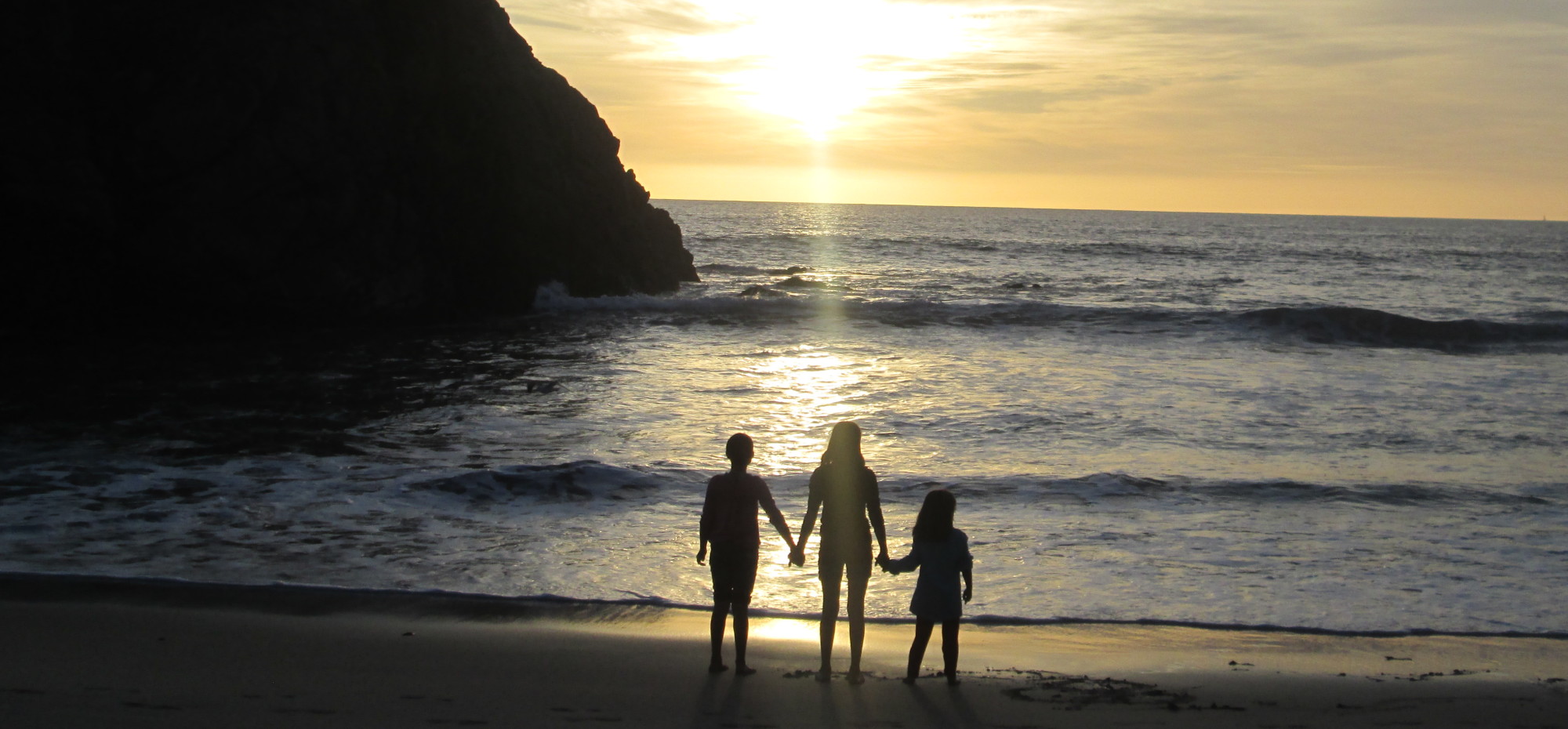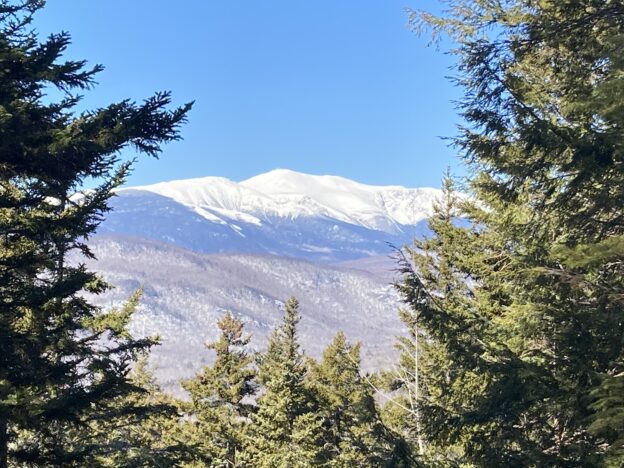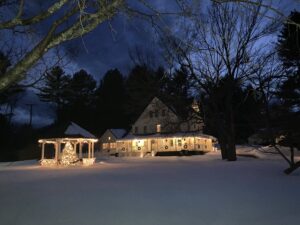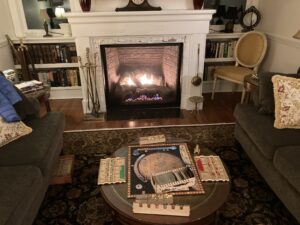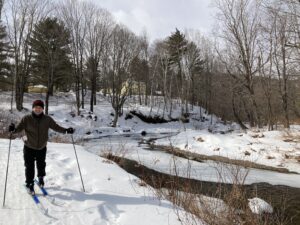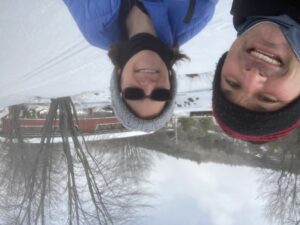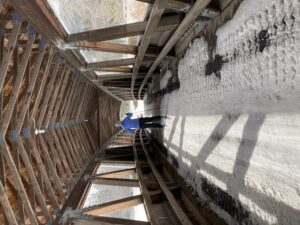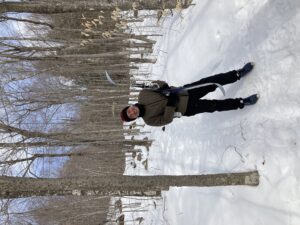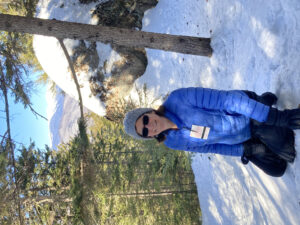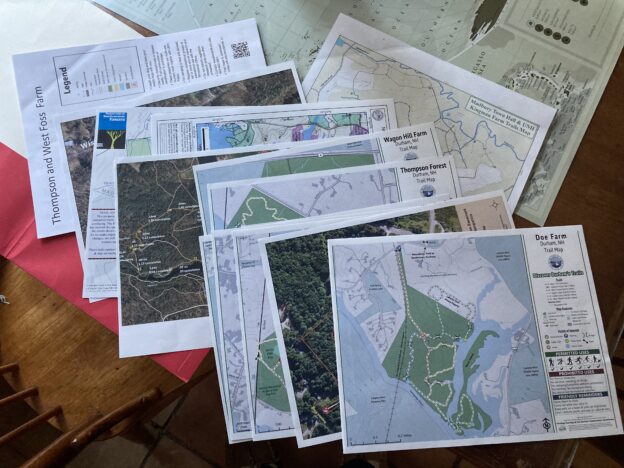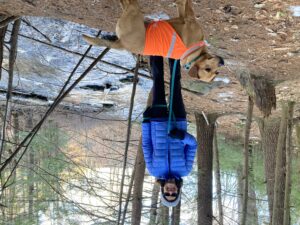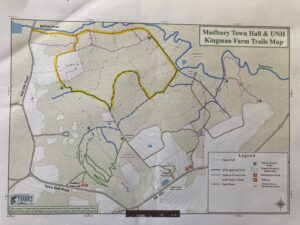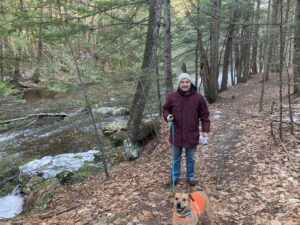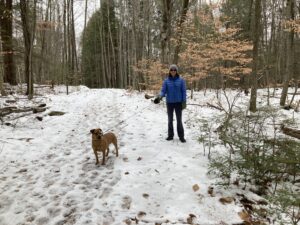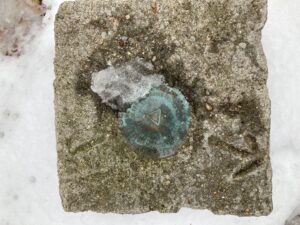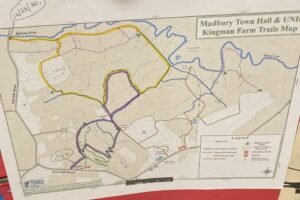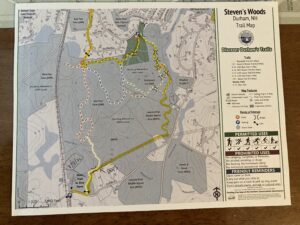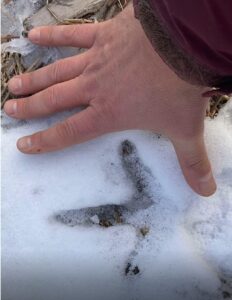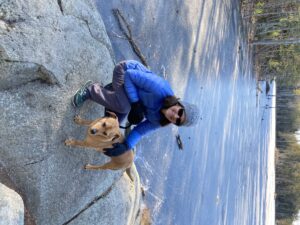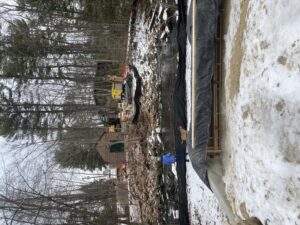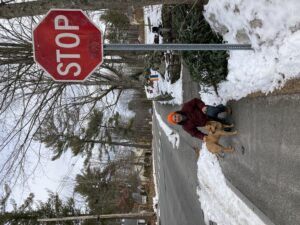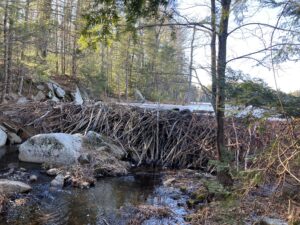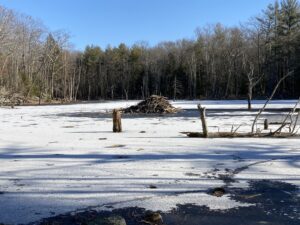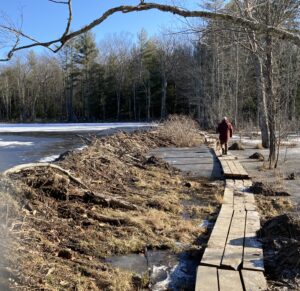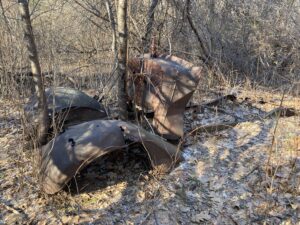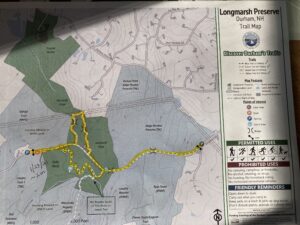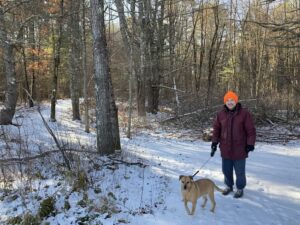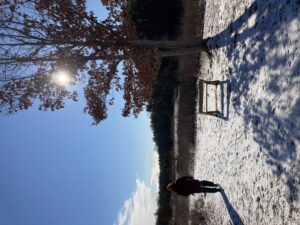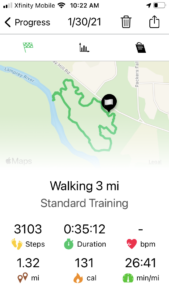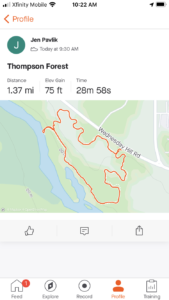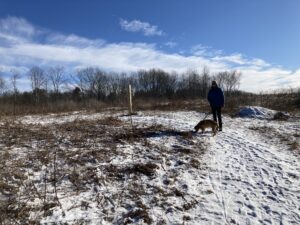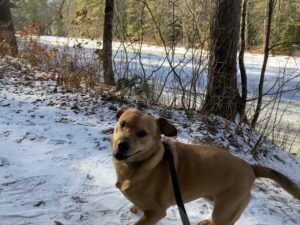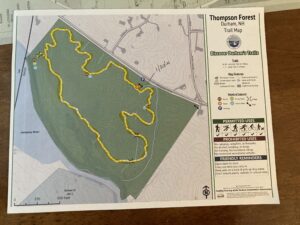We generally alternate planning an anniversary weekend getaway each year, but I’ve been slacking off a bit. I should have planned one for fall 2019, but we were so busy with school stuff and college visits and kids’ sports — plus a fun weekend trip to NYC with friends — that it didn’t quite happen. Then 2020 rolled around and things were even worse — lockdowns and travel restrictions, Zoe starting college and the other kids stuck schooling at home, social distancing preventing them from staying with various friends and family while we were away.
So when winter 2021 dropped a getaway opportunity in our laps, I seized it. Lanie is skiing at Sunday River with one of her friends in her “pod”, and Nadia is visiting colleges with her best friend. That, combined with Bob’s recent big birthday, made a perfect case for our first ever winter anniversarymoon trip. Options were, of course, somewhat more limited than usual. Because of COVID concerns and travel restrictions, we needed to stay in NH or ME. I wanted to have kitchen 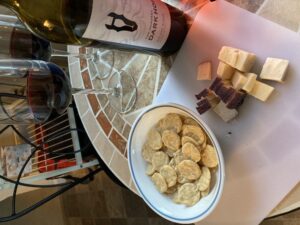 facilities so we wouldn’t have to eat at restaurants. And any activities we planned to do would need to be outdoors.
facilities so we wouldn’t have to eat at restaurants. And any activities we planned to do would need to be outdoors.
Fortunately, we found all of these things at the Riverwood Inn in Jackson. Our room included a kitchenette that allowed us to make most of our food. And its location in the mountains, directly on the Jackson XC cross country ski network and nearby to all manner of winter outdoor adventures, was perfect.
We arrived in the late afternoon on Wednesday and had the whole place to ourselves. We got a warm welcome from one of our hosts, James, who showed us around the first floor of the inn. (We stayed in the carriage house, a separate outbuilding, but were welcome to spend time in the inn’s lovely living room in front of the fire, sipping coffee, tea, or cocoa.)
 We decided to treat ourselves to dinner out for our first evening, assuming that if we went very early we’d avoid any crowds. Accordingly we strolled down the street to the Wildcat Tavern at 4:30, and initially were successful in our strategy. The Wildcat must get a big apres-ski crowd after the mountains close, though, because by the time we finished our (delicious) dinner, the place was pretty packed (at least by COVID standards). It was very odd being in a bar with live music and lots of people. Though it was a fun interlude in a way, we didn’t linger. Instead, we returned to the inn for a solitary evening playing a game by the fire.
We decided to treat ourselves to dinner out for our first evening, assuming that if we went very early we’d avoid any crowds. Accordingly we strolled down the street to the Wildcat Tavern at 4:30, and initially were successful in our strategy. The Wildcat must get a big apres-ski crowd after the mountains close, though, because by the time we finished our (delicious) dinner, the place was pretty packed (at least by COVID standards). It was very odd being in a bar with live music and lots of people. Though it was a fun interlude in a way, we didn’t linger. Instead, we returned to the inn for a solitary evening playing a game by the fire.
The next day, after a delicious breakfast prepared by James’s wife Susan, we headed out the back door to hit the cross country ski trails. Jackson XC maintains a huge network of groomed trails, and is one of the best places in New England for Nordic skiing. Bob and I are enthusiastic skiers, but not very skillful ones, so we started off skiing the loops around the large, semi-flat golf course right in Jackson village. We then crossed over the iconic covered bridge and headed out on the Eliis River Trail. This 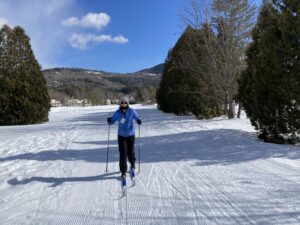 was rated as “easy” but still contained plenty of challenges for us, especially with the somewhat icy conditions. (We just cannot figure out how you are supposed to stop, or turn, on these skis. If your instincts take over and you attempt to do it the way you would on downhill skis, disaster quickly ensues. So we approach every downhill, especially those that involve a curve, with great trepidation.)
was rated as “easy” but still contained plenty of challenges for us, especially with the somewhat icy conditions. (We just cannot figure out how you are supposed to stop, or turn, on these skis. If your instincts take over and you attempt to do it the way you would on downhill skis, disaster quickly ensues. So we approach every downhill, especially those that involve a curve, with great trepidation.)
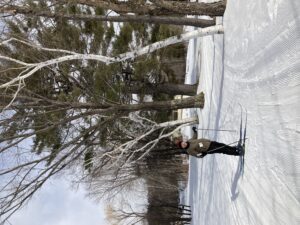 Well, we managed to get out and back on the river trail without serious incident, and wanted to keep going. We were hoping to make our way to the Eagle Mountain House for a trailside snack and some skiing on the network of green (easy) trails surrounding it. Unfortunately there was an ominous section of blue — 1.1 miles, to be exact — that we would have to traverse to get back to the green area. We decided to give it a try, figuring we could always take off our skis and walk down any particularly scary hills.
Well, we managed to get out and back on the river trail without serious incident, and wanted to keep going. We were hoping to make our way to the Eagle Mountain House for a trailside snack and some skiing on the network of green (easy) trails surrounding it. Unfortunately there was an ominous section of blue — 1.1 miles, to be exact — that we would have to traverse to get back to the green area. We decided to give it a try, figuring we could always take off our skis and walk down any particularly scary hills.
A few tenths of a mile in, we were rethinking this plan. We’d been duck-walking the whole way (nearly falling over repeatedly in the process), up a trail that climbed ever more steeply. We already knew there was no way in hell we’d be able to ski back down — in fact we couldn’t understand how it would even be possible for ANYONE to ski back down, without careening off the icy path into the trees at very high speeds. After close to half a mile of this, with no end in sight, we threw in the towel. Fortunately, we were close to a snowshoe trail that was sufficiently packed down for us to walk on — so, carrying our skis, we retreated in defeat.
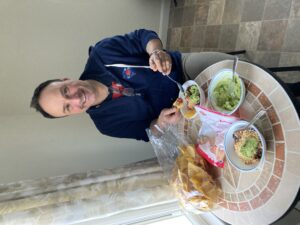
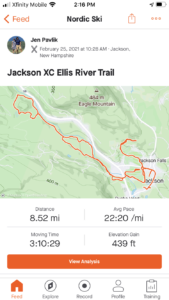 Luckily we were able to console ourselves with wine and cheese followed by a delicious dinner that we’d set up in our crockpot that morning. We enjoyed another evening of games by the fire (we’re still the only guests here) followed by a much-needed early bedtime.
Luckily we were able to console ourselves with wine and cheese followed by a delicious dinner that we’d set up in our crockpot that morning. We enjoyed another evening of games by the fire (we’re still the only guests here) followed by a much-needed early bedtime.
Because we’d skied earlier this week at Sunday River, and because Lanie was telling us ski conditions weren’t great, we decided to go for a winter hike the next day rather than pulling out our downhill skis. Fortified by another excellent breakfast and large pot of coffee, we drove up to the Tin Mountain 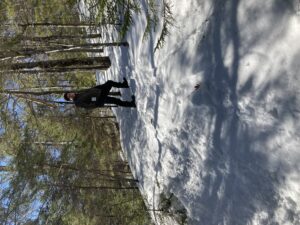 Conservation Area on the infamous Tin Mine Rd. (We were in Jackson last month with the whole family and our
Conservation Area on the infamous Tin Mine Rd. (We were in Jackson last month with the whole family and our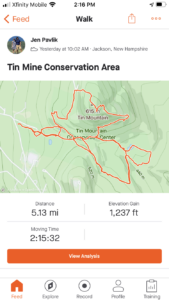 friends the Halls, in a big rental house way, way up on the mountain. After a semi-disastrous day attempting to ski in a blizzard, we found ourselves unable to drive up said Tin Mine Rd., and had to abandon our cars and hike the rest of the way back to our house while jumping into the snowbanks on the side of the road anytime a car came skidding by.) Luckily the weather was clear and we were able to make it up the steep track without incident.
friends the Halls, in a big rental house way, way up on the mountain. After a semi-disastrous day attempting to ski in a blizzard, we found ourselves unable to drive up said Tin Mine Rd., and had to abandon our cars and hike the rest of the way back to our house while jumping into the snowbanks on the side of the road anytime a car came skidding by.) Luckily the weather was clear and we were able to make it up the steep track without incident.
This was a beautiful place for a hike. Technically these are snowshoe trails, but they’ve been packed down enough that we were able to walk in just our boots –– though stepping off the side of the trail resulted in sinking up to your knees. The nice thing about this area is that it’s crisscrossed with many trails, but there are signs at every junction and they all loop back on each other — so you can just wander pretty freely with confidence that you’ll eventually end up back at the Grand Junction. We eventually made our way to the summit, up some pretty steep paths, and earned great views of Mount Washington as well as Attitash and Black ski areas. Getting back down was less elegant, and we sometimes resorted to sliding on our bottoms. We were enjoying our walk in the 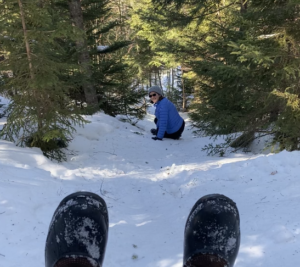 woods so much that we just kept taking new side routes to visit the various landmarks mentioned in the signs — the summit, the pond, the old tin mine, the stone boundary wall. It was a very pleasant, if strenous, few hours.
woods so much that we just kept taking new side routes to visit the various landmarks mentioned in the signs — the summit, the pond, the old tin mine, the stone boundary wall. It was a very pleasant, if strenous, few hours.
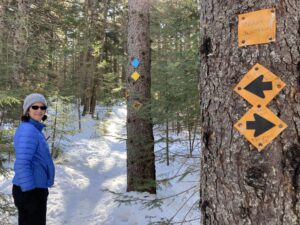 James had noticed that we had brought some of our complicated strategy games with us, and so that morning he’d shown us a game that earlier visitors had accidentally left behind — Wingspan. We’d heard of this and were eager to try it out, so that’s how we spent our late afternoon. (Seemed like a good game, and not too difficult to learn, although neither of us felt like we had much of a grasp on the strategy.) We also took the opportuntity to visit the nearby White Mountain Puzzles store and stock up — I’ve been doing a lot of puzzles these days.
James had noticed that we had brought some of our complicated strategy games with us, and so that morning he’d shown us a game that earlier visitors had accidentally left behind — Wingspan. We’d heard of this and were eager to try it out, so that’s how we spent our late afternoon. (Seemed like a good game, and not too difficult to learn, although neither of us felt like we had much of a grasp on the strategy.) We also took the opportuntity to visit the nearby White Mountain Puzzles store and stock up — I’ve been doing a lot of puzzles these days.
Today was Saturday — time for us to head back home. The inn had filled up the night before, so there were a lot more people at breakfast than we were used to. (This did allow us to overhear a funny conversation — a rare instance of womansplaining. Wife: “These tablecloths have really nice embroidery. Embroidery is when you take a needle and –“. Husband (testily): “I know what embroidery is.”)
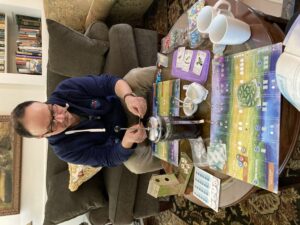 Along with the new
Along with the new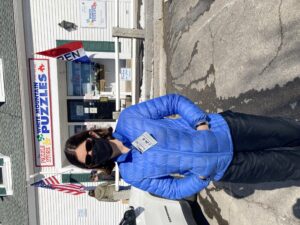 guests, snow also arrived — just in time for our drive home. Given the weather we didn’t linger — though we did make a quick stop in North Conway to visit the Naked Bohemian store and pick some cool garden art for the lake. The kids don’t return until tomorrow, so we’re taking the opportunity to have a dinner that they wouldn’t like and one more quiet evening.
guests, snow also arrived — just in time for our drive home. Given the weather we didn’t linger — though we did make a quick stop in North Conway to visit the Naked Bohemian store and pick some cool garden art for the lake. The kids don’t return until tomorrow, so we’re taking the opportunity to have a dinner that they wouldn’t like and one more quiet evening.
